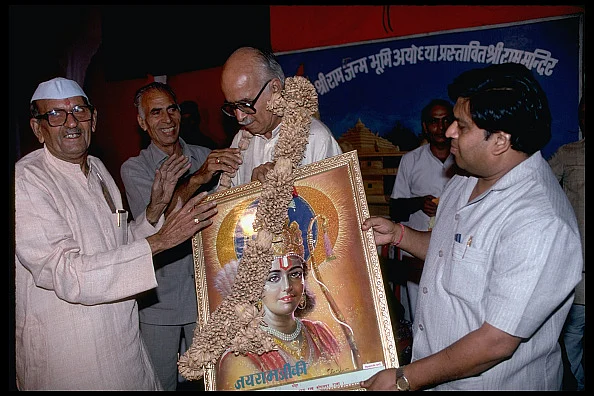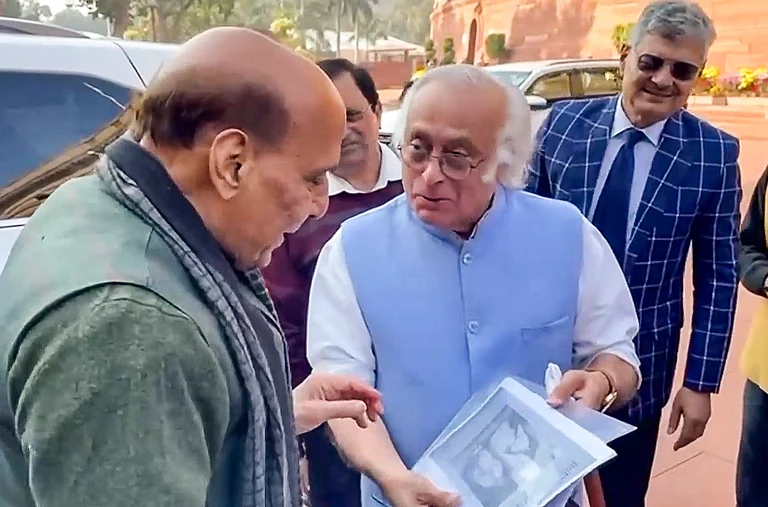Last year, in the run-up to the Madhya Pradesh state assembly elections, the former Chief Minister and senior Congress leader Kamal Nath during an interview proudly said that one shouldn’t forget that Rajiv Gandhi opened the locks of Babri Masjid. The statement though in the context of elections was read as an electoral strategy of the grand old party that was allegedly pandering to the Hindu sentiments, their decision to not attend the consecration ceremony in Ayodhya on January 22 has put it in the lurch.
However, the dilly-dally of Congress over the Babri Masjid-Ram Janmabhoomi dispute is not new. Since the beginning of the controversy in 1949 when people allegedly barged into the mosque premises and placed the idol of Ram paving the way for a decades-long fight, the Congress has been in a perpetual quandary.
Following the incident that the SC later termed a ‘criminal act’, Prime Minister Jawaharlal Nehru wrote to the then Chief Minister Govind Ballabh Pant asking him to remove the idol. However, the Faizabad Congress MLA Baba Raghav Das immediately opposed any such action and threatened to resign from the assembly. Sardar Patel even threw his hat into the ring and warned against any such ‘unilateral action’.
If this was the beginning of Congress’s complicity in the demolition of Babri Masjid and the consequent foundation of Ram temple, the politics of the 1980s made the party a facilitator. Since the 1950s, the residents of Ayodhya used to celebrate Ram Prakat Utsav to commemorate the auspicious moment when the statue of Ramlalla suddenly appeared in the mosque. However, by the late 1970s, the intensity of the celebration lost its earlier gusto.
But in the early 1980s, the VHP with its relentless campaign restored the energy and on January 4, 1984, hundreds of people climbed on the central dome and hoisted the Hanuman flag. Nilanjan Mukhopadhyay in his book The Demolition and the Verdict, notes, “As in December 1949, the news spread like wildfire and on getting to know about this, ‘massive crowds’ began gathering outside the shrine. Several prominent mahants of Ayodhya, too, arrived and performed a yagna inside the sanctum sanctorum.”
This incident that charged up an otherwise dying movement, nonetheless, happened during the tenure of Sripati Mishra, who was the Congress CM of UP for around 2 years. In 1982, Mishra started Ramayan Mela in Ayodhya which continues to the day. Though much about Mishra’s political career is not talked about, PM Modi’s comment on Mishra in 2021 made headlines. While talking about the former CM, PM Modi said that the Congress ‘humiliated’ him during his tenure. Notably, Rakesh Mishra, son of the former CM and an MLC of Congress in the 1980s joined BJP in 2016.

The enthusiastic celebration of January led to VHP holding Dharam Sansad on April 7-8 where “they adopted a resolution ‘unanimously’ calling for ‘restoration’ of the three religious sites, first featured in the August 1949 Hindu Mahasabha resolution: Varanasi, Ayodhya, and Mathura,” writes Mukhopadhyay. Notably, the Sansad was held at the government-owned Vigyan Bhavan and was attended by more than 1000 religious leaders from different sects. To say that the Congress government didn’t have prior information regarding the resolutions is seemingly anachronistic as Mukhopadhyay notes, “There was a buzz of excitement that the temple demand would be included in the charter and a definite timeline for an agitation would be announced.”
The Congress government’s silence on the Dharam Sansad and its resolution can be considered the preliminary turn of the grand old party away from its celebrated secular credentials; the events unfolded in 1985-1986 facilitated an ideological shift. As Rajiv Gandhi brought in a law to overturn the Shah Bano judgement allegedly to appease the Muslim minorities, the VHP started reaping the political benefits. Along with the UP Congress leader Dau Dayal Khanna, Ashok Singhal reached out to government officials pushing them to open the gate of the mosque.
Meanwhile, in a change of political course, Narayan Dutt Tewari resigned as the UP CM as he was being inducted into the union cabinet. Rajiv Gandhi, on the suggestion of Arun Nehru - a leader who was gaining massive clout in Congress during the 1980s - chose lesser-known Virbhadra Singh as Tewari’s successor. But Singh was the last person whom Congress could afford to have at a time of emerging communal frenzy. Mani Shankar Aiyar in his book, Memoir of a Maverick, writes, “The new chief minister visited Ayodhya in December 1985 and stirred up a hornets’ nest by ordering that all files relating to the closure of the gates be reviewed. Meanwhile, a case was filed by a private party before the sessions judge, Faizabad, to reopen the locks.”
Though the mosque was locked by an executive order; on February 1, 1986, a Judicial order by a Faizabad court opened it. It not only opened merely a lock; it opened the Pandora’s box. In the words of Aiyar, “Within minutes of the order being passed in Faizabad, the locks at Ayodhya, closed for over thirty-five years, were broken open and, in what appeared to be an orchestrated move, huge numbers of Hindu devotees poured into the masjid premises. Clearly, the administration was in cohorts with the district sessions court.”
The BJP which faced an electoral drubbing in 1984 knew very well that it was their chance to gain political mileage. With the communal frenzy, grew BJP’s number of seats and the V P Singh government came to power. However, this government couldn’t sustain itself for long and after the fall of both Singh and Chandrasekhar government, the nation witnessed another election. In 1991, Congress though managed to form the government, BJP became the second-largest party with almost 20 per cent votes and 120 seats.

The ensuing communal riots in the backdrop of Advani’s Ratha Yatra and the UP CM Kalyan Singh’s decision to buy land near the disputed site led the Rao government to pass the Placement of Worship Act, 1991. During the debate on the bill, left leaders Somnath Chatterjee and Ram Vilas Paswan minced no words in criticising Congress’s complicity in opening the gate of the mosque. However, Babri Masjid was exempted from the law and a few Congress leaders even challenged it citing that the frenzy over the dispute was the original ground for tabling this act.
Notably, even on the day of demolition, a question arises over the silence of CRPF. Rao earlier said that the structure would be safeguarded as Kalyan Singh made the promise to the apex court. It is nevertheless not clear how the mob escaped the spot without being detained. Though Singh was forced to resign immediately after, the Rao government cannot avoid the responsibility. Association of Indian Progressive Study Groups (AIPSG) in its statement in 1993, wrote, “Successive central governments and the present Congress (I) government in particular deliberately presented the Ayodhya issue as a dispute between some Hindu and Muslim leaders and experts, with the government trying to "strike a deal" between the "two sides".”
While talking about the complicity of Congress, political scientist Satish K Jha says, “Since the Congress was a ruling dispensation both at the centre and in the state of UP at the most crucial moments in the long saga of the Ramjanambhoomi dispute, it cannot fully exonerate itself from both the destruction of the mosque and the construction of the temple. Ideologically it is a liability for it as it was never tied to such an agenda in politics.”
The debates on the Placement of Worship Act, 1991 in the parliament show that the Congress wanted to settle the issue in a judicial manner while the BJP wanted political handover of the disputed site. And there lies Congress’s failure to measure it. CSDS-based political analyst Praveen Rai says, “The Congress failed in pursuing the title suit of Ram Janambhoomi and bringing it to its logical end which resulted in a purely legal issue metamorphosing into a political conflagration that spurred the vigilante destruction of the disputed structure.”
The grand old party’s decision to welcome the SC verdict with open hands, however, again exposes their confusing stance over the dispute. But why did they decline the invitation calling the consecration an ‘RSS-BJP’ event? Rai thinks that there are two reasons. Firstly, the decision not to attend is driven more by the maxim ‘A bird in the hand is worth two in the bush' rather than correcting its old dilly-dallying stand on this issue. Their refusal revalidates the party's secular credentials and will help in polarising and consolidating minority votes in the 2024 General elections.

Secondly, though it vindicates the alleged 'Pro-Muslim and Anti-Hindu' perception of the grand old party, it may not lead to further desertion of its majoritarian support base, as it has already lost staunch traditional Hindu voters to the BJP in the last two national elections, adds Rai.
Jha, nonetheless, is not on the same board as Rai. Pointing out that the minorities might not immediately react to it, he says, “The decision not to go for the consecration ceremony is not going to absolve it in the eyes of the minorities.” However, it is too early to gauge the reaction of the majority community to this decision of the Congress. Given the polarised nature of electoral politics today, it definitely will have some impact on some sections of the majority voters, he adds.
The social justice parties like SP, and RJD, however, don’t have such a burden as Congress. Since their very inception, they have been fighting against the Kamandal politics. Though Akhilesh Yadav primarily was found to be a bit confused over attending the inauguration ceremony, later on with other INDIA bloc members, he also joined the ‘not in RSS-BJP event’ bandwagon.
In this contrasting history, the Congress’s complicity in Ram Mandir is not very difficult to gauge. But the question remains - is it the end of the perennial dilemma?



























